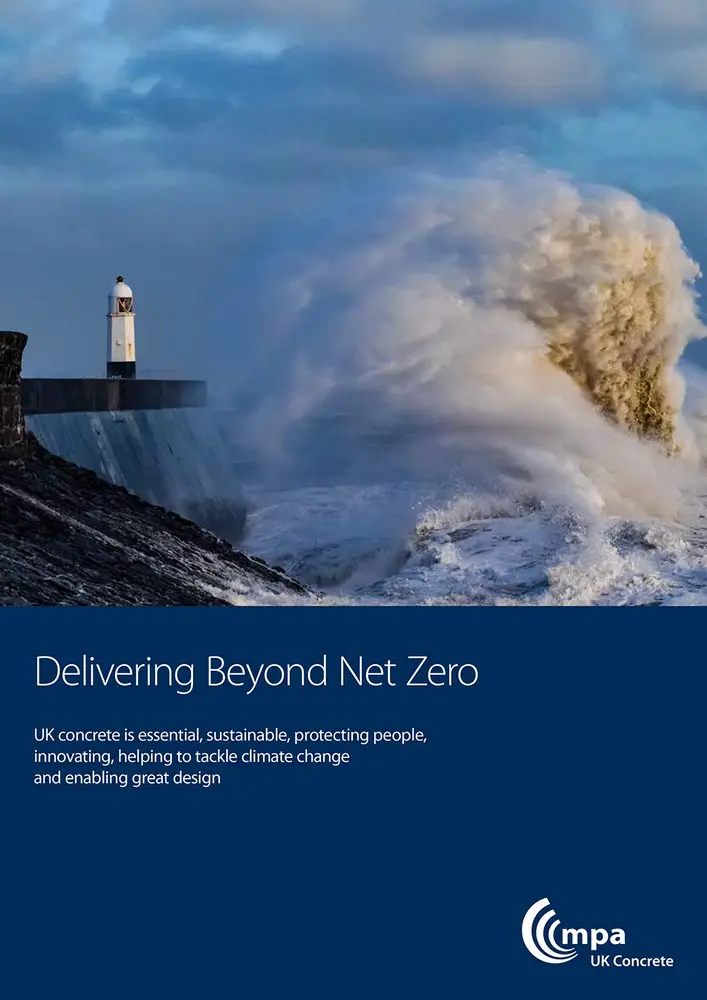Concrete, Delivering beyond net Zero Buildings, Mineral Products Association, Architects, Links
Concrete – Delivering beyond net Zero Article
17 June 2020
Article from mpa
Delivering beyond net Zero
Delivering beyond net Zero
Concrete is essential for our economy and our way of life, now and in the future. New homes, schools, hospitals, workplaces, roads and railways, as well as the infrastructure that provides us with clean water, sanitation and renewable energy, all create the demand for concrete and cement. Achieving net zero carbon emissions requires the wholesale decarbonising of all aspects of production and supply. The concrete and cement industry will play its part in the UK’s transition to a net zero economy, switching energy sources, product innovation, changing production processes, modernising transportation and solving built environment challenges.
In this document UK Concrete, part of the Mineral Products Association (MPA) and representing the UK’s concrete industry, states how it is addressing the challenge of delivering net zero as a top priority.
The roadmap being created by UK Concrete, which details how the industry will deliver beyond net zero, will also provide a framework for other MPA sectors.
Together these sector plans will become a net zero approach for mineral products. These products, aggregates, asphalt, cement, concrete, dimension stone, lime, mortar and silica sand, represent the largest material flow in our economy and are critical to our quality of life.
Concrete is the world’s most versatile and sought-after man-made material, made by mixing aggregates with cement and water.
Concrete’s versatility provides uses that form the foundation and fabric of our built environment, both onshore and offshore, above ground, on the ground and below our feet.
Cement is a key constituent of concrete and its production gives rise to just less than 1.5 per cent of UK CO₂ emissions. To put this in context, this is five times less than the 7 per cent contribution of the global cement industry.
Cement production and the use of concrete has the unique potential to go beyond net zero by 2050 with scope to deliver net negative emission removals. The challenge of achieving this is considerable and the solutions are not taken for granted, as much work is required to demonstrate that they are technically and economically deliverable.
The concrete and cement industry is committed to achieving net zero as soon as technically and economically possible but is not pretending that it will be either quick or easy.
The emerging UK Concrete decarbonisation roadmap will detail innovative solutions to eliminate emissions from production and utilises the properties of concrete to go beyond net zero.
Achieving net zero will require significant collaborative effort with supportive Government policy measures to go beyond the actions that have already delivered a 53 per cent CO₂ reduction in UK concrete and cement production emissions since 1990.
Our plan for concrete
Concrete and cement are essential to delivering a net zero carbon and circular economy, and already deliver a substantial biodiversity ‘net gain’. To realise our ambition, UK Concrete will set out a bold and credible path beyond net zero, potentially removing carbon dioxide from the atmosphere.
Our net zero roadmap will not rely on offsetting, so the significant tree-planting and habitat creation our industry has delivered over the last 50 years as part of its business as usual operations represents a biodiversity ‘net gain’ to complement its emissions reduction.
The roadmap aims to avoid any offshoring of production and carbon leakage. The UK’s carbon budgets could, but should not, be partially met by importing goods rather than manufacturing in the UK.
The concrete and cement roadmap will foster low carbon domestic production and help to retain economic value and jobs in the UK while meeting the highest environmental standards and delivering a sustainable built environment.
The UK has strategic natural assets that can help to place the UK as a world leader in decarbonisation infrastructure. Local concrete and cement production is ideally placed to assist in both the development and utilisation of these assets.
The plan will explore the potential of a range of technology levers including fuel switching, low-carbon cements and Waste Bio-Energy Carbon Capture, Utilisation and Storage (WBECCUS) to eradicate production emissions, and use the natural CO₂ absorbing properties of concrete, known as carbonation, to go beyond zero to net negative emissions.
We recognise that significant mitigation relies upon the ability to access and deploy carbon capture; a technology not currently economically available at scale. Industrial Carbon Capture, Utilisation and Storage (CCUS) should be urgently prioritised to demonstrate the real contribution it can make. Without this solution net zero and beyond will be unattainable with current technologies for a number of manufacturing sectors, not just cement.
Policy enablers
Implementing these technological and systemic changes will require very significant investment by industry which will require support from Government, similar to the policy and financial support that has driven renewables development and deployment. Energy Intensive Industries offer great potential for deep decarbonisation yet currently this presents unmanageable competitive and financial risk.
System wide changes
Government intervention and assistance is essential to set the economic and industrial framework to deliver our net zero roadmap.
How we account for carbon dioxide is vitally important. Measuring emissions associated with our consumption, not just production, is essential if the UK is to take responsibility for the emissions it causes. This avoids the ‘easy option’ of offshoring production, which only moves rather than cuts emissions, to meet UK domestic targets as well as damaging the UK economy and putting UK jobs at risk.
Government should not rely on climate change mitigation alone, as that leaves the UK vulnerable to the inaction of other regions. Precautionary climate change adaptation is an important part of the policy to protect our communities and critical national infrastructure. Our industry stands ready to supply the resilient materials needed.
Technology and infrastructure
Government needs to quickly set the framework in which rapid industrial decarbonisation can take place.
Large scale infrastructure for transport and storage of CO₂, deployment of a hydrogen network, facilitating large scale bio-energy and increased grid capacity to enable electrification are all areas where Government should take the lead.
As a major consumer of mineral products Government procurement should support locally produced low carbon concrete and cement in preference to imported construction materials.
Financial
Implementing the innovations needed to decarbonise requires financial support of the key technologies. This is especially relevant for the capital and operational costs of carbon capture. Support is needed so that CCUS is an investable proposition but also to enable the development of CO₂ utilisation processes and markets for products consuming captured CO₂.
The concrete and cement industry supports the ambition to decarbonise as soon as possible and is working hard every day to achieve it, but we will not be able to do it alone. The industry will work with Government to realise our shared goal as well as setting out in our roadmap what will be required to achieve beyond net zero carbon emissions by 2050.
Concrete – Delivering beyond net Zero image / information received 170620
Climate Change – Sustainable Architecture
A seleciton of recent climate change posts on e-architect:
Sustainable Architecture: Climate Change
UN Climate Change Conference Paris Deal
Population Growth Drives Housing Crisis
Ground granulated blast furnace slag in concrete production: GGBS
Climate Change Resource
Some useful links:
Sustainable Buildings : Brief informal discussion re some of the issues
Sustainable Architecture Links
Sustainable Build: www.sustainablebuild.co.uk
Avaaz campaign: https://secure.avaaz.org/campaign/en/the_planet_is_dying_b/
Comments / photos for the Concrete is causing climate catastrophe page welcome








